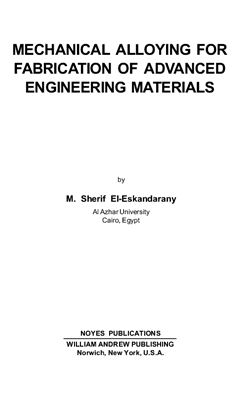Noyes Publications, Norwich, NY, 2001. 242 pp.
The mechanical alloying (MA) process, using ball-milling and/or rod-milling techniques, has received much attention as a powerful tool for fabrication of several advanced materials, including equilibrium, nonequilibrium (e.g., amorphous, quasicrystals, nanocrystalline, etc.), and composite materials. In addition, it has been employed for reducing some metallic oxides by milling the oxide powders with metallic reducing agents at room temperature. In fact, MA is a unique process in that a solid state reaction takes place between the fresh powder surfaces of the reactant materials at room temperature. Consequently, it can be used to produce alloys and compounds that are difficult or impossible to be obtained by conventional melting and casting techniques.
The mechanical alloying (MA) process, using ball-milling and/or rod-milling techniques, has received much attention as a powerful tool for fabrication of several advanced materials, including equilibrium, nonequilibrium (e.g., amorphous, quasicrystals, nanocrystalline, etc.), and composite materials. In addition, it has been employed for reducing some metallic oxides by milling the oxide powders with metallic reducing agents at room temperature. In fact, MA is a unique process in that a solid state reaction takes place between the fresh powder surfaces of the reactant materials at room temperature. Consequently, it can be used to produce alloys and compounds that are difficult or impossible to be obtained by conventional melting and casting techniques.

